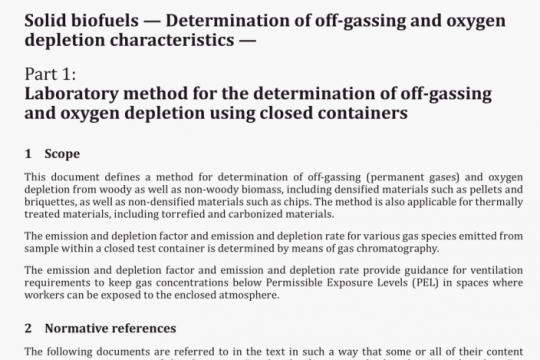ISO 20904 pdf free download
ISO 20904-2020 pdf free download.Hard coal – Sampling of slurries.
4 Principles ofsampling slurries
4.1 General
For the purposes ofthis document, a slurry is defined as fine coal, coal rejects or tailings ofnominal top size <4 mm that is mixed with water, which is frequently used as a convenient form to transport coal, rejects or tailings though plant circuits by means of pumps and pipelines and under gravity in launders or chutes or through long distances in slurry pipelines. Tailings from wet plants are also discharged as a slurry through pipelines to the tailings dam. In many of these operations, collection of increments at selected sample points is required for evaluation ofthe coal or rejects in the slurry.
A lot or sub-lot sample is constituted from a set of unbiased primary increments from a lot or sub- lot. The sample container is weighed immediately after collection and combination of increments to avoid water loss by evaporation or spillage. Weighing is necessary to determine the mass percentage of solids in the lot or sub-lot sample. The lot or sub-lot sample can then be filtered, dried and weighed. Alternatively, the lot or sub-lot sample may be sealed in plastic bags after filtering for transport and drying at a later stage.
Except for samples for which their characteristics are determined directly on the slurry, test samples are prepared from lot or sub-lot samples after filtering and drying. Test portions may then be taken from the test sample and analysed using an appropriate and properly calibrated analytical method or test procedure under specified conditions.
The objective of the measurement chain is to determine the characteristic of interest in an unbiased manner with an acceptable and affordable degree of precision. The general sampling theory, which is based on the additive property ofvariances, can be used to determine how the variances of sampling, sample preparation and chemical analysis or physical testing propagate and hence determine the total variance for the measurement chain. This sampling theory can also be used to optimize mechanical sampling systems and manual sampling methods.
If a sampling scheme is to provide representative samples, it is necessary that all parts of the slurry in the lot have an equal opportunity of being selected and appearing in the lot sample for testing. Any deviation from this basic requirement can result in an unacceptable loss of accuracy. A sampling scheme having incorrect selection techniques, i.e. with non-uniform selection probabilities, cannot be relied upon to provide representative samples.
Sampling of slurries should preferably be carried out by systematic sampling on a time basis (see Clause 10). If the slurry flow rate and the coal-solids concentration vary with time, the slurry volume and the dry solids mass for each increment will vary accordingly. It is necessary to show that no systematic error (bias) is introduced by periodic variation in quality or quantity where the proposed sampling interval is approximately equal to a multiple of the period of variation in quantity or quality.
L Otherwise, stratified random sampling should be used (see Clause 11).
Best practice for sampling slurries is to mechanically cut freely falling streams (see Clause 12), with a complete cross-section of the stream being taken during the traverse of the cutter. Access to freely falling streams can sometimes be engineered at the end of pipes or by incorporating steps or weirs in launders and chutes. If samples are not collected in this manner, non-uniform concentration of coal solids in the slurry due to segregation and stratification of the solids can lead to bias in the sample that is collected. Slurry flow in pipes can be homogenous with very fine particles dispersed uniformly in turbulent suspension along the length and across the diameter of the pipe. However, more commonly, the slurry in a pipe has significant particle-concentration gradients across the pipe and there can be concentration fluctuations along the length of the pipe. These common conditions are called heterogeneous flow. Examples of such flow are full-pipe flow of a heterogeneous suspension or partial-pipe flow of a fine suspension above a slower moving or even stationary bed of coarser particles in the slurry.
For heterogeneous flow, bias is likely to occur where a tapping is made into the slurry pipe to locate either a flush-fitting sample take-off pipe or a sample tube projecting into the slurry stream for extraction of samples. The bias is caused by non-uniform concentration profiles in the pipe and the different trajectories followed by particles of different masses due to their inertia, resulting in larger or denser particles being preferentially rejected from or included in the sample.
In slurry channels such as launders, heterogeneous flow is almost always present, and this nonuniformity in particle concentration is usually preserved in the discharge over a weir or step. However, sampling at a weir or step allows complete access to the full width and breadth of the stream, thereby enabling all parts of the slurry stream to be collected with equal probability.
Sampling of slurries in stationary situations, such as a settled or even a well-stirred slurry in a tank, holding vessel or dam is not recommended, because it is virtually impossible to ensure that all parts of the slurry in the lot have an equal opportunity of being selected and appearing in the lot sample for testing. Instead, sampling should be carried out from moving streams as the tank, vessel or dam is filled or emptied.
4.2 Sampling errors
4.2.1 General
The processes of sampling, sample preparation and measurement are experimental procedures, and each procedure has its own uncertainty appearing as variations in the final results. When the average of these variations is close to zero, they are called random errors. More serious variations contributing to the uncertainty of results are systematic errors, which have averages biased away from zero. There are also human errors that introduce variations due to departures from prescribed procedures for which statistical analysis procedures are not applicable.ISO 20904 pdf download.




